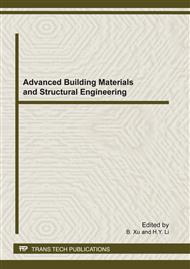p.435
p.440
p.444
p.448
p.453
p.457
p.461
p.466
p.470
Phosphorus in Drinking Water and it's Removal in Conventional Treatment Process
Abstract:
Chemical forms of phosphorus in source and treated drinking water were studied in this paper. Removal of total phosphorus (TP) and microbially available phosphorus (MAP) by conventional treatment process of drinking water was examined. The results showed that particulate phosphorus constituted of most TP in source water. Content of total soluble phosphate (TSP) was about 30% of TP. Soluble reactive phosphate (SRP) can be measured in a few months during a year and its content was very low. Content of MAP was higher than content of TSP in source water, which showed that microbe can also use particle phosphorus. Ratio of TSP to TP increased evidently in treated water. This demonstrated that removal of TSP was more difficult than particulate phosphorus in conventional treatment process for drinking water. Removal of TP and MAP in conventional treatment process of drinking water was effective, with averaged removal efficiency of 66% and 69%, respectively. Coagulation-sedimentation and filtration removed TP efficiently. Enhanced coagulation may increases removal efficiency of MAP. Lower content of MAP can control biostability of drinking water.
Info:
Periodical:
Pages:
453-456
Citation:
Online since:
February 2012
Authors:
Price:
Сopyright:
© 2012 Trans Tech Publications Ltd. All Rights Reserved
Share:
Citation:


